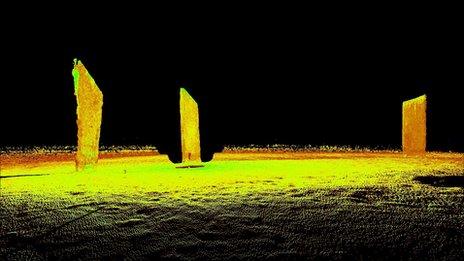Neolithic Orkney sites scanned in 3D
- Published

The Stones of Stenness are being scanned to produce 3D images of the site
Laser scanners are being deployed in Orkney to record details of some of the island's key historical landmarks.
A team from Glasgow School of Art and Historic Scotland will scan the chambered tomb of Maeshowe, the Ring of Brodgar and Skara Brae settlement.
The two-week project is part of a plan to build up three-dimensional images of 10 World Heritage sites.
Among the sites already scanned are New Lanark's 18th Century mills and Mount Rushmore in South Dakota.
'Comparing data'
The Heart of Neolithic Orkney is made up of the tomb of Maeshowe, the Stones of Stenness, the Barnhouse Stone, the Watch Stone, the Ring of Brodgar and Skara Brae.
The recording process will involve a laser being fired millions of times a second at each of the monuments.
The end result will be a precise record of the sites, accurate down to just millimetres.
The data will be used to assess the physical condition of the structures and provide a foundation for future conservation, site management and aid archaeological understanding.
Project leader Dr Lyn Wilson said: "Though we have already scanned New Lanark, the scale and nature of the monuments will be an entirely different challenge.
"This will be the first site in the Scottish Ten project where we have existing scan data: comparing data acquired at different dates will allow us to measure any changes in condition of the monuments."
Sites including the Antonine Wall, St Kilda, and the Old and New Towns of Edinburgh will also be scanned.